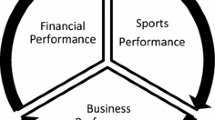Abstract
Using winning percentage as a well-established proxy for market success, this article proposes a method for estimating the relative contributions of players to victories as an assessment of their worth—that is, their value to team owners or their greatness as judged by sports fans. Specifically, the proposed approach regresses winning percentage on adjusted measures of team performance (with the players of interest omitted) plus quasi-dummy variables coded to represent the participation rates of the relevant players. Though this approach lends itself to use across a wide variety of sports (professional or college football, basketball, hockey, baseball, and so on) and situations (such as season, league, and history of team), it is described primarily in the context of major league baseball and is illustrated by means of a specific empirical application to the case of the New York Yankees.
Similar content being viewed by others
References
Anderson, Dave. (1995). “Mattingly's Typically Quiet Exit.” New York Times, November 19, Sports Sunday, 1.
Baseball Encyclopedia: The Complete and Definitive Record of Major League Baseball, The (9th ed.). (1993). New York: Macmillan.
Burgess, Paul L., and Daniel R. Marburger. (1992). “Bargaining Power and Major League Baseball.” in Sommers (1992, pp. 50–59).
Chass, Murray. (1995a). “Mattingly Falls Far in Latest Rankings.” New York Times, November 1, B13.
Chass, Murray. (1995b). “This Season's Most Valuable Players, Pro and Con.” New York Times, September 24, Sports Sunday, 11.
Fort, Rodney. (1992). “Pay and Performance: Is the Field of Dreams Barren?” In Sommers (1992, pp. 134–160).
Gimbel, Mike. (1994). Baseball Player and Team Ratings: 1994 Edition. Brooklyn: Boerum Street Press.
Hadley, Lawrence, and ElizabethGustafson. (1991). “Major League Baseball Salaries: The Impacts of Arbitration and Free Agency.” Journal of Sport Management 5 (July), 111–127.
Holbrook, Morris B, and Clifford J. Shultz II. (1996). “An Updating Model of Salary Adjustments in Major League Baseball: How Much Is a Home Run Worth?” Working Paper, Graduate School of Business, Columbia University.
James, Bill. (1993). The Bill James Player Ratings Book 1993. New York: Collier Books.
Johnson, Bruce K. (1992). “Team Racial Composition and Players' Salaries.” In Sommers (1992, pp. 189–202).
Moran, Malcolm. (1995). “Heisman: So Close, It's Hard to Call.” New York Times, December 8, B19.
Porter, Philip K. (1992). “The Role of the Fan in Professional Baseball.” in Sommers (1992, pp. 63–76).
Quirk, James, and Rodney D.Fort. (1992). Pay Dirt: The Business of Professional Team Sports. Princeton, NJ: Princeton University Press.
Scully, Gerald W. (1974). “Pay and Performance in Major League Baseball.” American Economic Review 64 (December), 915–930.
Scully, Gerald W. (1989). The Business of Major League Baseball. Chicago: University of Chicago Press.
Scully, Gerald W. (1995). The Market Structure of Sports. Chicago: University of Chicago Press.
Siwoff, Seymour, SteveHirdt, TomHirdt, and PeterHirdt. (1993). The 1993 Elias Baseball Analyst. New York: Simon & Schuster.
Smith, Claire. (1995). “Vaughn Edges Belle as A.L.'s Most Valuable.” New York Times, November 17, B19.
Sommers, Paul M. (ed.). (1992). Diamonds Are Forever: The Business of Baseball. Washington, DC: Brookings Institution.
Vecsey, George. (1996). “Nice to See Standards Somewhere.” New York Times, January 13, Sports Saturday, 31.
Vernon, John A. (1992). “Baseball, Bubble Gum, and Business.” in Sommers (1992, pp. 91–106).
Zimbalist, Andrew. (1992). “Salaries and Performance: Beyond the Scully Model.” In Sommers (1992, pp. 109–133).
Zimbalist, Andrew. (1994). Baseball and Billions: A Probing Look Inside the Big Business of Our National Pastime (updated ed.). New York: Basic Books.
Author information
Authors and Affiliations
Rights and permissions
About this article
Cite this article
Holbrook, M.B. Market success as a criterion for assessing player contributions in sports businesses via a regression-based approach using adjusted performance measures and quasi-dummy variables. Market Lett 7, 341–353 (1996). https://doi.org/10.1007/BF00435541
Received:
Revised:
Accepted:
Issue Date:
DOI: https://doi.org/10.1007/BF00435541




